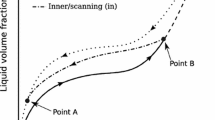Abstract
The main features of a numerical model that predicts the mechanisms of ionic transport in unsaturated cement systems are described. The model, called STADIUM, is divided into four parts: ionic diffusion, moisture transport, chemical reactions, and chemical damage. The diffusion of all ions present in the system is modeled by solving the extended Nernst-Planck/Poisson set of equations. The model takes into account the electrical coupling between the various ionic species in solution and chemical activity effects. The transport of water by capillary suction is described by a diffusion equation. In the model, the transport phenomena and the chemical reactions are uncoupled. Phase dissolution and precipitation phenomena are modeled through a separate chemical equilibrium code. The model considers the influence of chemically induced microstructural alterations on the transport properties of the material. A brief description of the model is presented in the first sections of this paper. Typical applications of the model are given in the last section.
Résumé
Ce document présente les principales caractéristiques d’un modèle numérique permettant de prédire le comportement de matériaux cimentaires exposés dans des conditions non saturées à des environements chimiquement agressifs. Le modèle est divisé en quatre parties traitant respectivement du transport d’ions par diffusion, du transport de l’eau, des réactions chimiques et de l’endommagement chimique. La diffusion des ions est décrite en résolvant l’équation de Nernst-Planck étendue. Le modèle prend en considération les effets reliés à l’activité chimique des ions en solution et le couplage électrique entre les différents flux ioniques. Le transport de l’eau par succion capillaire est décrit par une équation de diffusion. Les phénomènes de dissolution/précipitation sont modélisés en utilisant un module d’équilibre chimique. Les effets des réactions chimiques sur la structure poreuse du matériau et ses propriétés de transport sont également considérés. Une brève description du modèle est donnée dans la première partie du document. Des exemples d’application du modèle sont présentés dans la seconde partie.
Similar content being viewed by others
References
Nilsson, L. O., Poulsen, E., Sandberg, P., Sorensen, P. and Klinghoffer, O., ‘HETEK-Chloride penetration into concrete’, Report No 53, (The Road Directorate, Copenhagen, Denmark, 1996).
Marchand, J., Gérard, B. and Delagrave, A., ‘Ion transport mechanisms in cement-based materials’,Materials Science of Concrete, Vol. V, American Ceramic Society (1998) 307–400.
Bentz, D. P., Clifton, J. R. and Snyder, K. A., ‘Predicting the service life of chloride-exposed steel-reinforced concrete’,Concrete International 18 (12) (1996) 42–47.
Bear, J. and Bachmat, Y., ‘Introduction to modeling of transport phenomena in porous media’, (Kluwer Academic Publishers, The Netherlands, 1991).
Samson, E., Marchand, J. and Beaudoin, J. J., ‘Describing ion diffusion mechanisms in cement-based materials using the homogenization technique’,Cem. Concr. Res. 29 (8) (1999) 1341–1345.
Helfferich, F., ‘Ion Exchange’, (McGraw-Hill, USA, 1962).
Weast, R. C., Astle, M. J. and Beyer, W. H., Eds.), ‘CRC Handbook of Chemistry and Physics’, 66th Edn (CRC Press, Florida, USA, 1986).
Samson, E., Lemaire, G., Marchand, J. and Beaudoin, J. J., ‘Modeling chemical activity effects in strong ionic solutions’,Comp. Matls. Sci. 15 (1999) 285–294.
Samson, E. and Marchand, J., ‘Numerical solution for the extended Nernst-Planck model’,J. Coll. Interface Sci.,215 (1999) 1–8.
Samson, E., Marchand, J., Snyder, K. A. and Beaudoin, J. J., ‘Describing ion transport mechanisms in unsaturated cement-based materials using the homogenization technique’, (in preparation).
Pel, L., ‘Moisture transport in porous building materials, Ph.D. Thesis, Technical University of Eindhoven (The Netherlands, 1995).
Samson, E. and Marchand, J., ‘New algorithms for modeling dissolution/precipitation reactions in cement-based materials’, (in preparation).
Grove, D. B. and Wood, W. W., ‘Prediction and field verification of subsurface-water quality during artificial recharge-Lubbock, Texas’,Groundwater 17 (3) (1979) 250–257.
Barbarulo, R., Marchand, J., Snyder, K. A. and Prené, S., ‘Dimensional analysis of ionic transport problems in hydrated cement systems—Part 1: Theoretical considerations’,Cem. Concr. Res. (2000) (in press).
Garboczi, E. J. and Bentz, D. P., ‘Computer simulation of the diffusivity of cement-based materials’,J. Matls. Sci. 27 (1992) 2083–2092.
Samson, E., Marchand, J., Robert, J. L. and Bournazel, J. P., ‘Modeling ion diffusion mechanisms in porous media’,Int. J. Num. Meth. Eng. 46 (1999) 2043–2060.
Zienkiewicz, O. C. and Taylor, R. L., ‘The Finite-Element Method’, 4th Edn (McGraw-Hill, USA, 1989).
Taylor, H. F. W., ‘Cement chemistry’, (Academic Press Inc., San Diego, USA, 1990).
Longuet, P., Burglen, L. et Zelwer, A., ‘La phase liquide du ciment hydraté, Publication Technique CERILH, 219.
Reardon, E. J., ‘An ion interaction model for determing ion equilibria in cement/water systems’,Cem. Concr. Res. 20 (1) (1990) 175–192.
Powers, T. C. and Brownyard, T. L., ‘Studies of the physical properties of hardened Portland cement paste (Nine parts)’,J. Americ. Concr. Inst.,43 (1946–47).
Hall, C., ‘Barnier performance of concrete: A review of fluid transport theory’,Mater. Struct. 27 (1994) 291–306.
Maltais, Y., Marchand, J. and Stutzman, P., ‘Chemical degradation of cement-based materials upon sulfate attack under saturated and unsaturated conditions’, (in preparation).
Marchand, J., Maltais, Y. and Samson, E., ‘Behavior of saturated cement systems exposed to sodium sulfate solutions’, (in preparation).
Author information
Authors and Affiliations
Additional information
Editorial Note Prof. Jacques Marchand presented a lecture of this paper at the 2000 RILEM Annual Meeting in Paris, France, when he was awarded the 2000 Robert L’hermite Medal in recognition of his outstanding contributions to the explanation of corrosion mechanisms in concrete, in particular HPC. Jacques Marchand is a RILEM Senior Member. He works at Laval University (Canada), a Titular Member and is the Chaiman of RILEM TC FHP (“Predicting the frost resistance of high performance concrete exposed to numerous freezing and thawing cycles”). He is also the Secretary of RILEM TC 181-EAS (“Early age shrinkage induced stresses and cracking in cementitious systems”).
Rights and permissions
About this article
Cite this article
Marchand, J. Modeling the behavior of unsaturated cement systems exposed to aggressive chemical environments. Mat. Struct. 34, 195–200 (2001). https://doi.org/10.1007/BF02480588
Received:
Accepted:
Issue Date:
DOI: https://doi.org/10.1007/BF02480588




